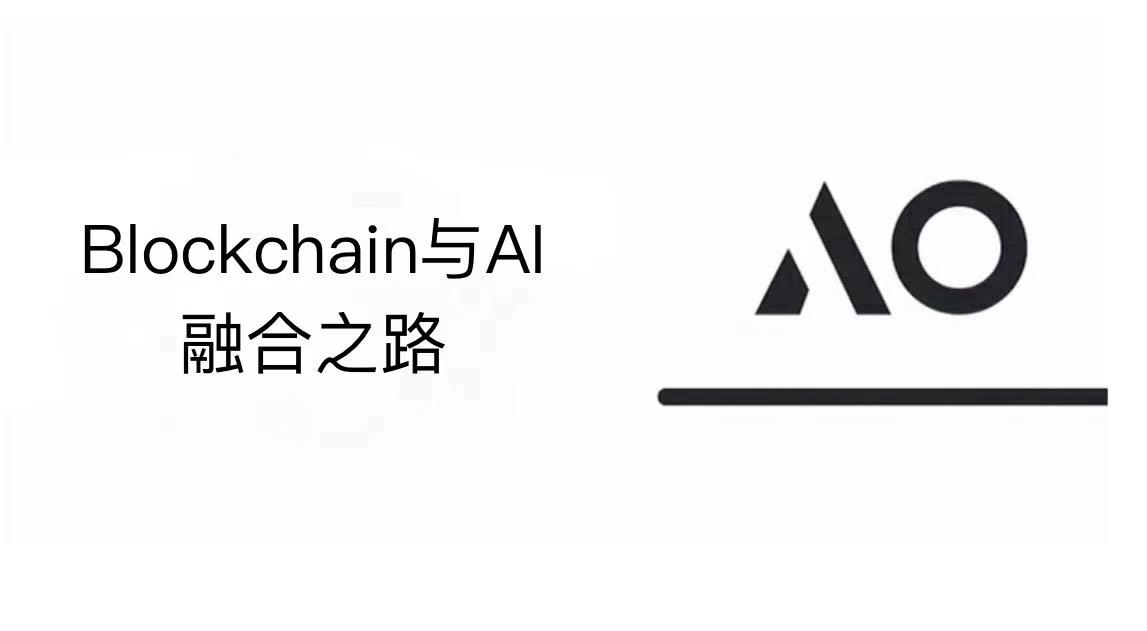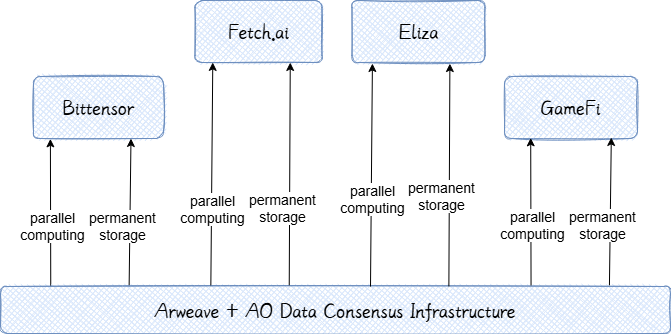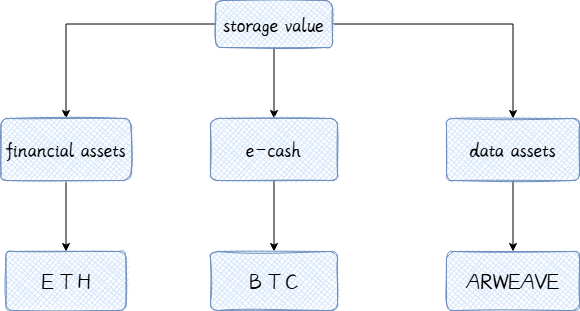
Author: Qin Jingchun
Reviewer: Leon Lee
Source: Content Association - Investment Research
Originally published on: PermaDAO
Original link: https://permadao.com/permadao/AO-Arweave-AI-1ad27607c43980178fe9f03f495d54d4
In recent years, with the rapid development of AI technology and the increasing demand for large model training, decentralized AI infrastructure has gradually become a hot topic in the industry. Although traditional centralized computing platforms have been continuously upgraded in computing power, their data monopoly and high storage costs are also increasingly showing their limitations. On the contrary, decentralized platforms can not only reduce storage costs, but also ensure that data and calculations cannot be tampered with through decentralized verification mechanisms, thus playing an important role in key links such as AI model training, reasoning and verification. In addition, Web3 currently has data fragmentation, inefficient DAO organizations, and poor interoperability among platforms. Therefore, it must be integrated with decentralized AI to develop further!
This article will compare and analyze the advantages and disadvantages of various mainstream platforms from four dimensions: memory limitations, data storage, parallel computing capabilities, and verifiability, and discuss in detail why the AO+Arweave system shows obvious competitive advantages in the field of decentralized AI.
1. Comparative analysis of various platforms: Why AO+Arweave is unique
1.1 Memory and computing power requirements
As the scale of AI models continues to expand, memory and computing power have become key indicators for measuring platform capabilities. For example, running a relatively small model (such as Llama-3-8 B) requires at least 12 GB of memory; and models like GPT-4 with more than a trillion parameters have even more staggering requirements for memory and computing resources. During the training process, a large number of matrix operations, backpropagation, and parameter synchronization operations require full use of parallel computing capabilities.
AO+Arweave : AO can split tasks into multiple subtasks for simultaneous execution through its parallel computing unit (CU) and Actor model, achieving fine-grained parallel scheduling. This architecture not only fully utilizes the parallel advantages of hardware such as GPUs during training, but also significantly improves efficiency in key links such as task scheduling, parameter synchronization, and gradient updates.
ICP : Although the ICP subnet supports a certain degree of parallel computing, it can only achieve coarse-grained parallelism when executed inside a unified container, which makes it difficult to meet the needs of fine-grained task scheduling in large-scale model training, resulting in insufficient overall efficiency.
Ethereum and Base Chain : Both use a single-threaded execution mode. Their architectural design was originally intended for decentralized applications and smart contracts. They do not have the high parallel computing capabilities required to train, run, and verify complex AI models.
Computing power demand and market competition
With the popularity of projects such as Deepseek, the threshold for training large models continues to decrease, and more and more small and medium-sized companies may join the competition, resulting in an increasing shortage of computing resources in the market. In this case, decentralized computing infrastructure with distributed parallel computing capabilities like AO will become more and more popular. As the infrastructure of decentralized AI, AO+Arweave will become the key support for the implementation of Web3 value Internet.
1.2 Data Storage and Economics
Data storage is another crucial indicator. Traditional blockchain platforms, such as Ethereum, are usually only used to store key metadata due to the extremely high cost of on-chain storage, and large-scale data storage is transferred to off-chain solutions such as IPFS or Filecoin.
- Ethereum platform : Relying on external storage (such as IPFS, Filecoin) to save most of the data. Although it can ensure the immutability of the data, the high on-chain writing cost makes it impossible to store large amounts of data directly on the chain.
- AO+Arweave : Utilize Arweave's permanent low-cost storage capabilities to achieve long-term archiving and tamper-proof data. For large-scale data such as AI model training data, model parameters, training logs, etc., Arweave can not only ensure data security, but also provide strong support for subsequent model lifecycle management. At the same time, AO can directly call the data stored in Arweave to build a complete data asset economic closed loop, thereby promoting the implementation and application of AI technology in Web3.
- Other platforms (Solana, ICP) : Although Solana has optimized state storage through the account model, large-scale data storage still needs to rely on off-chain solutions; ICP uses built-in container storage and supports dynamic expansion, but long-term data storage requires continuous payment of Cycles, and the overall economics are more complicated.
1.3 The Importance of Parallel Computing Capabilities
In the process of training large-scale AI models, parallel processing of computationally intensive tasks is the key to improving efficiency. Splitting a large number of matrix operations into multiple parallel tasks can significantly reduce time costs while making full use of hardware resources such as GPUs.
- AO : AO achieves fine-grained parallel computing through independent computing tasks and message passing coordination mechanisms. Its Actor model supports splitting a single task into millions of sub-processes and efficient communication between multiple nodes. Such an architecture is particularly suitable for large model training and distributed computing scenarios. In theory, it can achieve extremely high TPS (transactions per second). Although it is actually subject to I/O restrictions, it far exceeds traditional single-threaded platforms.
- Ethereum and Base Chain : Due to the single-threaded EVM execution mode, both of them are unable to cope with complex parallel computing requirements and cannot meet the requirements of large AI model training.
- Solana and ICP : Although Solana's Sealevel runtime supports multi-threaded parallelism, the parallel granularity is relatively coarse, and ICP is still mainly single-threaded within a single container, which results in obvious bottlenecks when processing extremely parallel tasks.
1.4 Verifiability and System Trust
A major advantage of decentralized platforms is that they can greatly improve the credibility of data and computing results through global consensus and tamper-proof storage mechanisms.
- Ethereum : Through global consensus verification and zero-knowledge proof (ZKP) ecology, it ensures that the execution of smart contracts and data storage are highly transparent and verifiable, but the corresponding verification costs are relatively high.
- AO+Arweave : AO builds a complete audit chain by holographically storing all computing processes in Arweave and using a "deterministic virtual machine" to ensure the reproduction of results. This architecture not only improves the verifiability of computing results, but also enhances the overall trust of the system, providing strong protection for AI model training and reasoning.
2. The complementary relationship between AO+Arweave and vertical decentralized AI projects
In the field of decentralized AI, vertical projects such as Bittensor, Fetch.ai , Eliza and GameFi are actively exploring their respective application scenarios. As an infrastructure platform, AO+Arweave has the advantage of providing efficient distributed computing power, permanent data storage and full-chain auditing capabilities, which can provide the necessary basic support for these vertical projects.
2.1 Examples of technological complementarity
Bittensor :
Participants in Bittensor need to contribute computing power to train AI models, which places extremely high demands on parallel computing resources and data storage. AO's ultra-parallel computing architecture allows many nodes to perform training tasks simultaneously in the same network, and quickly exchange model parameters and intermediate results through an open message passing mechanism, thereby avoiding the bottleneck caused by the sequential execution of traditional blockchains. This lock-free concurrent architecture not only improves the model update speed, but also significantly improves the overall training throughput. At the same time, the permanent storage provided by Arweave provides an ideal preservation solution for key data, model weights, and performance evaluation results. The large data sets generated during the training process can be written to Arweave in real time. Due to the immutability of its data, any newly added node can obtain the latest training data and model snapshots, thereby ensuring that network participants can collaborate on training on a unified data basis. This combination not only simplifies the data distribution process, but also provides a transparent and reliable basis for model version control and result verification, allowing the Bittensor network to obtain computing efficiency close to that of a centralized cluster while maintaining the advantages of decentralization, thereby greatly promoting the performance ceiling of decentralized machine learning.
Fetch.ai ’s Autonomous Economic Agents (AEAs):
In the multi-agent collaborative system Fetch.ai , the combination of AO+Arweave can also show excellent synergy. Fetch.ai has built a decentralized platform that enables autonomous agents to collaborate on economic activities on the chain. Such applications need to handle the concurrent operation and data exchange of a large number of agents at the same time, which has extremely high requirements for computing and communication. AO provides Fetch.ai with a high-performance operating environment. Each autonomous agent can be regarded as an independent computing unit in the AO network. Multiple agents can execute complex operations and decision logic in parallel on different nodes without blocking each other. The open message passing mechanism further optimizes the communication between agents: agents can asynchronously exchange information and trigger actions through the on-chain message queue, thereby avoiding the delay problem caused by the global state update of the traditional blockchain. With the support of AO, hundreds of Fetch.ai agents can communicate, compete and cooperate in real time, simulating the rhythm of economic activities close to the real world. At the same time, Arweave's permanent storage capabilities enable Fetch.ai 's data sharing and knowledge retention. Each agent's important data generated or collected during operation (such as market information, interaction logs, protocol agreements, etc.) can be submitted to Arweave for storage, forming a permanent public memory library that other agents or users can retrieve at any time without trusting the reliability of centralized servers. This ensures that the records of collaboration between agents are open and transparent - for example, once the terms of service or transaction quotes issued by an agent are written into Arweave, they become public records recognized by all participants and will not be lost due to node failure or malicious tampering. With AO's high-concurrency computing and Arweave's trusted storage, the Fetch.ai multi-agent system can achieve unprecedented depth of collaboration on the chain.
Eliza Multi-Agent System :
Traditional AI chatbots usually rely on the cloud, process natural language through powerful computing power, and use databases to store long-term conversations or user preferences. With the help of AO's super-parallel computing, the on-chain intelligent assistant can distribute task modules (such as language understanding, dialogue generation, and sentiment analysis) to multiple nodes for parallel processing, and can respond quickly even if a large number of users ask questions at the same time. AO's message passing mechanism ensures efficient collaboration among modules: for example, the language understanding module extracts semantics and transmits the results to the response generation module through asynchronous messages, so that the conversation process under the decentralized architecture remains smooth. At the same time, Arweave acts as Eliza's "long-term memory bank": all user interaction records, preferences, and new knowledge learned by the assistant can be encrypted and permanently stored. No matter how long the interval is, the user can retrieve the previous context when interacting again to achieve personalized and coherent replies. Permanent storage not only avoids memory loss caused by data loss or account migration in centralized services, but also provides historical data support for continuous learning of AI models, making the on-chain AI assistant "smarter with use".
GameFi Live Proxy App :
In decentralized games (GameFi), the complementary characteristics of AO and Arweave play a key role. Traditional MMOs rely on centralized servers for a large number of concurrent calculations and state storage, which is contrary to the decentralized concept of blockchain. AO proposes to distribute game logic and physical simulation tasks to decentralized networks for parallel processing: for example, in the on-chain virtual world, scene simulations, NPC behavior decisions, and player interaction events in different regions can be calculated simultaneously by each node, and cross-region information can be exchanged through message passing to jointly construct a complete virtual world. This architecture abandons the bottleneck of a single server, allowing the game to linearly expand computing resources as the number of players increases, maintaining a smooth experience. At the same time, Arweave's permanent storage provides reliable state records and asset management for the game: key states (such as map changes, player data) and important events (such as rare item acquisition, plot progress) are regularly solidified as on-chain evidence; metadata and media content of player assets (such as character skins, item NFTs) are also directly stored to ensure permanent ownership and tamper-proof. Even if the system is upgraded or the nodes are replaced, the historical state saved by Arweave can still be restored to ensure that players' achievements and property are not lost due to technological changes: no player wants these data to disappear suddenly. There have been many similar incidents before, for example: Vitalik Buterin was furious when Blizzard suddenly cancelled the Life Straw skill of the magician in World of Warcraft many years ago. In addition, permanent storage also enables the player community to contribute to the game chronicles, and any important events can be retained on the chain for a long time. With the help of AO's high-intensity parallel computing and Arweave's permanent storage, this decentralized game architecture effectively breaks through the bottlenecks of traditional models in performance and data persistence.

2.2 Ecosystem Integration and Complementary Advantages
AO+Arweave not only provides infrastructure support for vertical AI projects, but is also committed to building an open, diverse, and interconnected decentralized AI ecosystem. Compared with projects that focus on a single field, AO+Arweave has a wider ecological scope and more application scenarios. Its goal is to build a complete value chain covering data, algorithms, models, and computing power. Only in such a huge ecosystem can the potential of Web3 data assets be truly released and a healthy and sustainable decentralized AI economic closed loop be formed.
3. Web3 Value Internet and Permanent Value Storage
The arrival of the Web3.0 era marks that data assets will become the most core resource on the Internet. Similar to the Bitcoin network storage of "digital gold", the permanent storage service provided by Arweave allows valuable data assets to be preserved for a long time and cannot be tampered with. At present, the monopoly of user data by Internet giants makes it difficult to reflect the value of personal data. In the Web3 era, users will have data ownership, and data exchange will be effectively realized through token incentive mechanisms.
Properties of a store of value :
Arweave has achieved powerful horizontal expansion capabilities through Blockweave, SPoRA and bundling technology, especially in large-scale data storage scenarios. This feature enables Arweave to not only undertake the task of permanent data storage, but also provide solid support for subsequent intellectual property management, data asset transactions and AI model lifecycle management.
Data asset economy :
Data assets are the core of Web3 value Internet. In the future, personal data, model parameters, training logs, etc. will become valuable assets, and can be efficiently circulated through token incentives, data rights confirmation and other mechanisms. AO+Arweave is an infrastructure built based on this concept, and its goal is to open up the circulation channels of data assets and inject continuous vitality into the Web3 ecosystem.

IV. Risks, Challenges and Future Prospects
Although AO+Arweave has many technical advantages, it still faces the following challenges in practice:
Complexity of economic models
The economic model of AO needs to be deeply integrated with the AR token economic system to ensure low-cost data storage and efficient data transmission. This process involves incentive and penalty mechanisms among multiple nodes (such as MU, SU, CU), and a flexible SIV sub-staking consensus mechanism must be used to balance security, cost, and scalability. In the actual implementation process, how to balance the number of nodes and task requirements and avoid idle resources or insufficient income is an issue that the project party needs to seriously consider.
Insufficient construction of decentralized models and algorithm markets
The current AO+Arweave ecosystem mainly focuses on data storage and computing power support, and has not yet formed a complete decentralized model and algorithm market. Without a stable model provider, the development of AI-Agent in the ecosystem will be restricted. Therefore, it is recommended to support decentralized model market projects through ecological funds to form high competitive barriers and long-term moats.
Despite many challenges, with the gradual arrival of the Web3.0 era, the confirmation and circulation of data assets will promote the reconstruction of the entire Internet value system. As a pioneer in infrastructure, AO+Arweave is expected to play a key role in this transformation and help build a decentralized AI ecosystem and Web3 value Internet.
in conclusion
Based on a detailed comparative analysis of the four dimensions of memory, data storage, parallel computing, and verifiability, we believe that AO+Arweave has demonstrated significant advantages in supporting decentralized AI tasks, especially in meeting the needs of large-scale AI model training, reducing storage costs, and improving system trust. At the same time, AO+Arweave not only provides strong infrastructure support for vertical decentralized AI projects, but also has the potential to build a complete AI ecosystem, thereby promoting the closed loop of Web3 data asset economic activities and bringing about greater changes. For more details, please refer to: https://mp.weixin.qq.com/s/h42BPZxGoZE1_C_UeDMOOQ.
In the future, with the continuous improvement of economic models, the gradual expansion of ecological scale, and the deepening of cross-field cooperation, AO+Arweave+AI is expected to become an important pillar of Web3 value Internet, bringing new changes to data asset rights confirmation, value exchange and decentralized applications. Although there are still certain risks and challenges in the actual implementation process, it is through continuous trial and error and optimization that technology and ecology will eventually usher in breakthrough progress.
The above content only represents personal opinions. All parties are welcome to discuss and exchange opinions!











